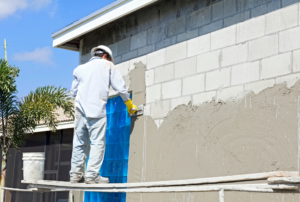Plumbers Orillia are tasked with installing and connecting pipes, fixtures, and appliances like sinks, toilets, showers, and water heaters. They also provide essential maintenance to keep these systems running smoothly.

Commercial plumbing is much more complex than residential plumbing. Large office buildings, malls, and manufacturing plants require plumbing on a grand scale that can handle more people and more rigorous demands.
Plumbing is one of the most important aspects of your home, but it’s often overlooked until something goes wrong. A residential plumber can help you keep your home’s plumbing systems in working order by performing routine maintenance and addressing issues as they arise. A residential plumber can also handle more complex projects such as installing water heaters and replacing or repairing toilets.
The plumbing system in your home is comprised of two main systems: the water supply system and the drainage system. These systems work together to deliver clean water to your faucets, showerheads, and appliances, while removing wastewater. When one of these systems fails, it can have serious consequences for your home’s health and safety. Whether you’re experiencing a clogged toilet, leaking pipe, or water heater issue, it’s important to call a plumber right away.
When you’re looking for a plumber, it’s important to find one that specializes in residential plumbing services. This ensures that they have the experience and knowledge needed to properly address your specific plumbing issues. You can usually find this information on a plumber’s website by checking their “About” page, which should include a description of their services and a list of past clients.
In addition to residential plumbing, some plumbers specialize in commercial plumbing. This type of plumbing is typically more involved and requires a higher level of skill and expertise. A commercial plumber can work in a wide range of industries, from hospitals and restaurants to hotels and office buildings. They can install complicated plumbing systems in these larger buildings, and they may be responsible for maintaining and repairing multiple fixtures at once.
While the differences between residential and commercial plumbing can seem subtle, they’re important to understand. Residential plumbers are trained to work on a variety of different plumbing issues, from simple clogs to more complex installations. They also have a strong understanding of building codes and regulations, which can help them navigate the complexities of working in a commercial setting. In addition, residential plumbers are typically on-call to handle after-hours emergencies, such as burst pipes or flooded kitchens.
Commercial
Commercial plumbing involves the installation, maintenance, and repair of large-scale water supply and waste drainage systems in office buildings, malls, hospitals, and other commercial spaces. Due to their size and complexity, these systems are more prone to damage than residential plumbing. As a result, they require more frequent inspections and service. This makes it important to hire a plumber with experience working on commercial properties.
Unlike residential plumbers, who work during standard business hours, commercial plumbers must be available around the clock to respond to emergency calls. This is because commercial spaces have higher usage rates than homes, which means that plumbing problems can happen more often and cause greater disruptions. Moreover, many businesses have strict regulations regarding their water use, so a malfunctioning pipe or fixture can quickly turn into a health or safety hazard.
Commercial plumbers must also have a wider range of tools and equipment than their residential counterparts. This includes high-powered drain cleaners, industrial wet and dry vacuums, tile saws, and more. Having access to this specialized equipment allows them to tackle more difficult and complex plumbing issues. It also helps them finish the job faster and more efficiently.
Another key difference between residential and commercial plumbing is the amount of time that it takes to resolve an issue. While most plumbers can handle basic plumbing issues, such as a clogged sink or toilet, it may take longer for them to diagnose and fix more complicated problems. This is because they must inspect the entire system and determine the root cause of the problem.
Aside from installing new fixtures, commercial plumbers can also repair existing ones. This includes toilets, faucets, shower heads, and pipes. In addition, they can install or replace kitchen and bathroom appliances like dishwashers and water heaters. However, this type of plumbing work requires more extensive and expensive repairs than simple fixes.
Because of the unique nature of their jobs, commercial plumbers must be knowledgeable about a wide variety of industries and building types. This way, they can provide effective and efficient solutions for all types of plumbing problems. For example, a plumbing problem in a restaurant must meet stringent health and safety requirements, while a leaky sink in a office tower can lead to serious structural damage and costly clean-up.
Industrial
Plumbers install and repair the pipes, fixtures, and appliances that facilitate water, gas, and waste disposal in residential, commercial, and industrial settings. They use tools to create watertight seals and connect components, as well as diagnostic equipment to identify problems such as leaks and clogs. They also perform routine maintenance to keep plumbing systems in good working order.
The type of work a plumber does depends on their employer and the industry in which they operate. For example, construction plumbers work on new building projects and collaborate with architects, engineers, and contractors to design and install plumbing systems according to specifications and blueprints. They may also be responsible for interpreting building codes and regulations, ensuring that plumbing systems are compliant with local guidelines.
Commercial plumbers service larger buildings, such as shopping malls, hospitals, and office towers. They typically have to deal with more complex plumbing issues, such as multiple water outlets and high usage rates. Additionally, they must be able to respond quickly to emergency calls and resolve problems such as burst pipes or flooded floors.
In some cases, industrial plumbers must install or repair machinery and equipment such as cooling systems, hydraulic lifts, and material handling systems. They are also responsible for maintaining plumbing systems in manufacturing facilities and other large-scale operations. This requires attention to detail as even small mistakes can lead to costly disruptions.
Because of the specialised nature of some industrial plumbing tasks, plumbers in this field often have to undergo additional training or certification. This can include completing an apprenticeship or attending a vocational school. It is also common for industrial plumbers to pursue continued education and training to stay abreast of industry advances and innovations. Moreover, industrial plumbers must be comfortable working in challenging conditions, such as confined spaces or with hazardous materials. This can require specific safety protocols and regular training drills.
Emergency
A plumbing emergency can happen at any time and when it does, you need to act fast. Whether it’s a blocked toilet, overflowing sink, or dangerous gas leak, it’s important to call a plumber right away to avoid costly repairs and to protect your family’s safety. But how do you know when it’s an actual emergency and not just a regular problem? It can be hard to tell, but there are some clear signs that you need to call a plumber immediately.
Water Damage
One of the most common reasons to call a plumber is for water damage. If left unchecked, water damage can lead to expensive repairs and even structural damage to your home. It’s important to act quickly when you notice any sign of water damage, especially if it’s caused by a burst pipe or flooding from a rainstorm.
Hidden Leaks
Hidden leaks can be a serious problem that can cause extensive water damage if not addressed immediately. Emergency plumbing services can help prevent and repair water damage by locating and fixing hidden leaks as soon as they occur.
Clogged Drains
A clogged drain can be very frustrating, especially when it stops your entire household from working properly. But it’s not always an emergency, and you can often fix it yourself by following some simple steps. For example, you can try pouring drain cleaner or hot water down the drain to loosen up any blockages. Or, you can put a strainer on your sink drain to catch any hair or soap scum that might be building up.
Sewage Backup
Sewage backup is another reason to call an emergency plumber right away. Not only does it smell awful, but it can also be a health hazard if not cleaned up promptly. Emergency plumbers can use special tools to clear the sewage backup and restore your home’s plumbing.
When you need a plumber for an emergency, it’s important to choose the best one available. Check online reviews and ratings to find a reputable plumber near you. You can also ask for recommendations from friends and neighbors. And don’t forget to check your local neighborhood directories and newspaper listings for plumbers. It’s also a good idea to keep the phone number for a trusted emergency plumber handy, just in case.








